1993 PONTIAC GRAND-AM fuel cap
[x] Cancel search: fuel capPage 93 of 306
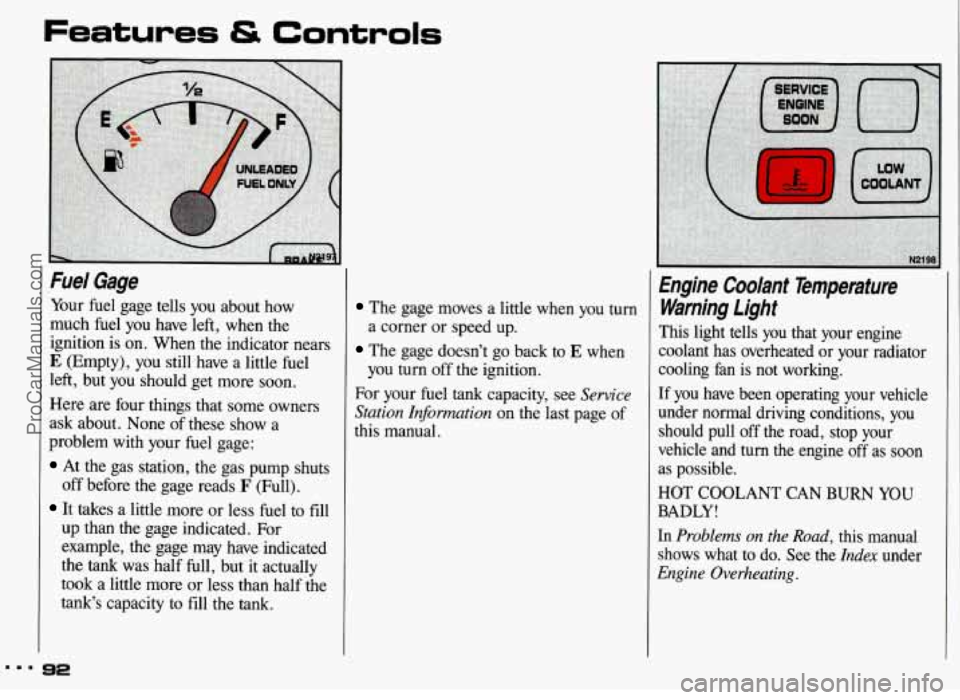
Fuel Gage
Your fuel gage tells you about how
much fuel you have left, when the
ignition is on. When the indicator nears
E (Empty), you still have a little fuel
left, but you should get more soon.
Here are four things that some owners
ask about. None
of these show a
problem with
your fuel gage:
At the gas station, the gas pump shuts
off before the gage reads
F (Full).
It takes a little more or less fuel to fill
up than the gage indicated. For
example, the gage may have indicated
the
tank was half full, but it actually
took a little more or less than half the
tank’s capacity to fill the tank.
The gage moves a little when you turn
The gage doesn’t go back to E when
For your fuel tank capacity, see
Service
Station Information
on the last page of
this manual. a
corner or speed up.
you turn off the ignition.
Engine Coolant Temperature
Warning Light
This light tells you that your engine
coolant has overheated or your radiator
cooling fan is not working.
If you have been operating your vehicle
under normal driving conditions, you
should pull off the road, stop your
vehicle and turn the engine
off as soon
as possible.
HOT
COOLANT CAN BURN YOU
BADLY!
In Problems on the Road, this manual
shows what to do. See the
Index under
Engine Overheating.
ProCarManuals.com
Page 104 of 306
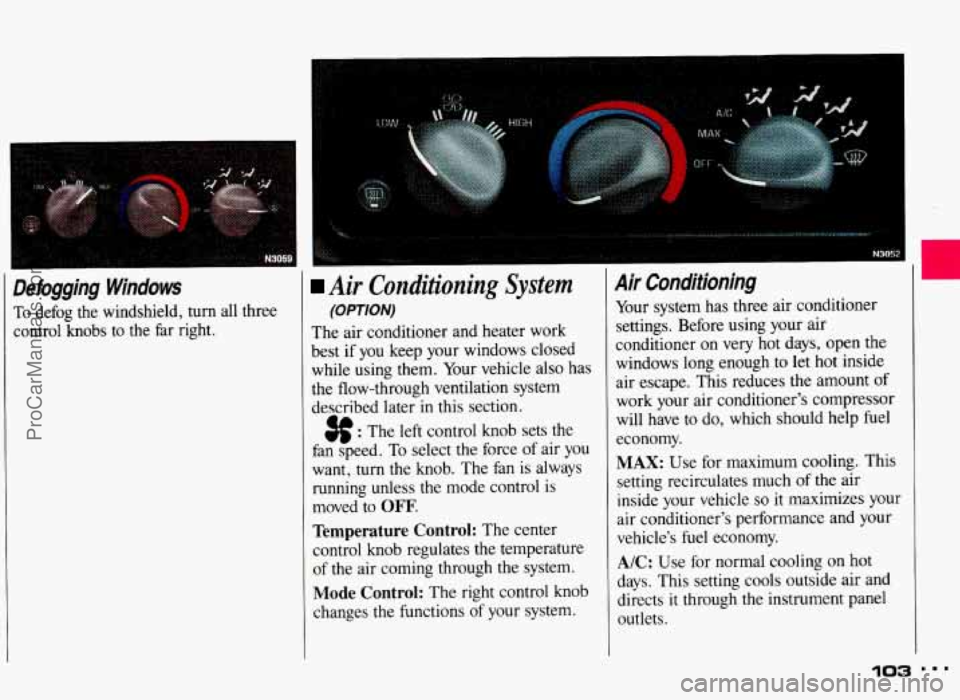
Defogging Windows
To defog the windshield, turn all three
control knobs to the far right.
I
I
Air Conditioning System
(OPTION)
The air conditioner and heater work
best if you keep your windows closed
while using them. Your vehicle also has
the flow-through ventilation system
described later
in this section.
3f : The left control knob sets the
fan speed. To select the force
of air you
want,
turn the knob. The fan is always
running unless the mode control is
moved to
OFF.
Temperature Control: The center
control knob regulates the temperature
of the air coming through the system.
Mode Control: The right control knob
changes the functions
of your system.
Air Conditioning
Your system has three air conditioner
settings. Before using your air
conditioner on very hot days, open the
windows long enough
to let hot inside
air escape. This reduces the amount
of
work your air conditioner's compressor
will have to do, which should help fuel
economy.
MAX: Use for maximum cooling. This
setting recirculates much
of the air
inside your vehicle
so it maximizes your
air conditioner's performance and your
vehicle's fuel economy.
A/C: Use for normal cooling on hot
days. This setting cools outside air and
directs it through the instrument panel
outlets.
103
ProCarManuals.com
Page 161 of 306
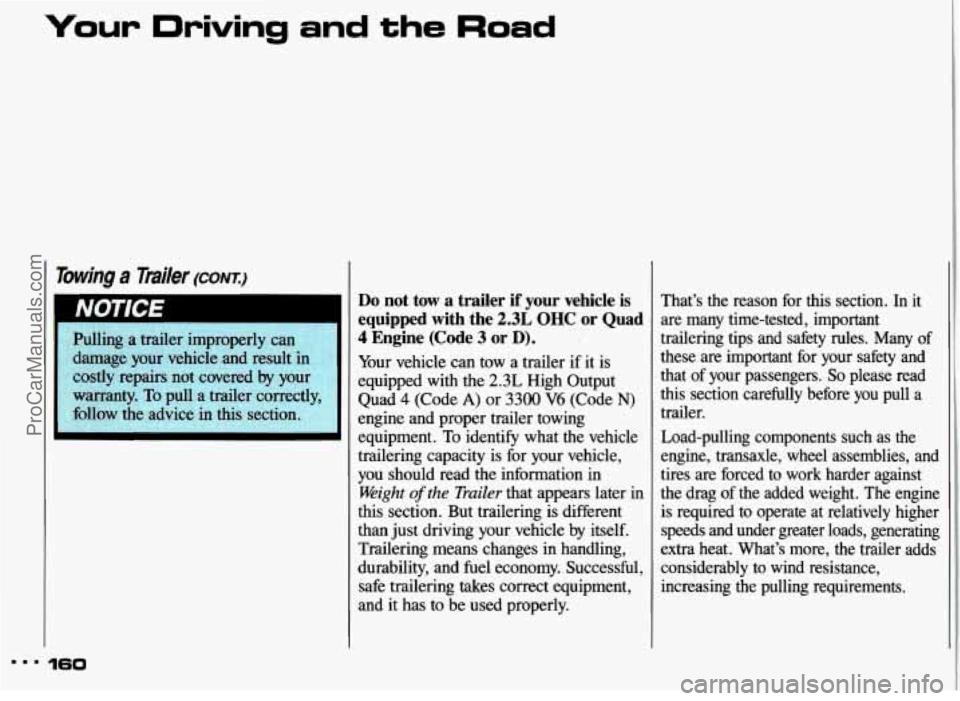
Your Driving and the Road
Towing a mailer (CONTJ
Pulling a trailer improperly can :i+-a .,, >
damage your vehicle and result inf. i,$i
costly repairs not covered by you$.<; .:
warranty. To pull a trailer correct&$; ’:
follow the advice in this section. ,,
’ ,,, . .
, , :i!
Do not tow a trailer if your vehicle is
equipped with the
2.3L OHC or Quad
4 Engine (Code 3 or D).
Your vehicle can tow a trailer if it is
equipped with the
2.3L High Output
Quad
4 (Code A) or 3300 V6 (Code N)
engine and proper trailer towing
equipment. To identify what the vehicle
trailering capacity is for your vehicle,
you should read the information
in
Weight of the Trailer that appears later in
this section. But trailering is different
than just driving your vehicle by itself.
Trailering means changes in handling,
durability, and fuel economy. Successful, safe trailering
takes correct equipment,
and it has to be used properly. That’s the reason for this section.
In it
are many time-tested, important
trailering tips and safety rules. Many
of
these are important for your safety and
that of your passengers.
So please read
this section carefully before you pull a
trailer.
Load-pulling components such as the
engine, transaxle, wheel assemblies, and
tires are forced to work harder against
the drag
of the added weight. The engine
is required to operate at relatively higher
speeds and under greater loads, generating
extra heat. What’s more, the trailer adds
considerably to wind resistance,
increasing the pulling requirements.
... 160
ProCarManuals.com
Page 198 of 306

Part 6
... N604
Here you will find information
about the care of your Pontiac
. This
part begins with service and fuel
information. and then it shows how
to check important fluid and
lubricant levels
. There is also
technical information about your
vehicle. and a section devoted to its
appearance care
.
Service & Appearance Care
Service ................ .................................. 198
Fuel
........................................................... 199
HoodRelease .................................................... 205
Engineoil
...................................................... 209
Aircleaner
...................................................... 214
Transaxle Fluid
.................................................. 216
Engine Coolant
.................................................. 221
Power Steering Fluid
.............................................. 224
Windshield Washer Fluid
........................................... 224
Brakes
......................................................... 225
Battery
......................................................... 227
BulbReplacement
................................................ 228
Windshield Wiper Blade Replacement
................................. 230
Loading Your Vehicle
............................................. 230
Tires
.......................................................... 232
Appearancecare
................................................. 239
Vehicle Identification Number (VIN)
................................. 247
Add-on Electrical Equipment
....................................... 248
Fuses
& Circuit Breakers ........................................... 248
Capacities
& Specifications ......................................... 251
Fluids
& Lubricants ............................................... 253
Replacement Bulbs
............................................... 254
Normal Maintenance Replacement
Parts ............................. 257
197
ProCarManuals.com
Page 202 of 306

If you’re using fuel rated at 91 octane or
higher and you still hear heavy
knocking, your engine needs service.
But don’t worry
if you hear a little
pinging noise when you’re accelerating
or driving up a hill. That’s normal and
you don’t have to buy a higher octane
fuel to get rid
of pinging. It’s the heavy,
constant knock that means you have a
problem.
What about gasoline with blending
materials that contain oxygen, such as
MTBE
or alcohol?
MTBE is “methyl tertiary-butyl
ether? Fuel that is no more than
15 %
MTBE is fine for your vehicle.
Ethanol is ethyl or grain alcohol.
Properly-blended fuel that is no more
than
10% ethanol is fine for your
vehicle.
Methanol is methyl or wood alcohol.
I
Fuel that is more than 5 %
methanol is bad for your vehicle.
Don’t use it. It can corrode metal
parts in your fuel system and also
damage plastic and rubber parts. That damage wouldn’t be covered
under your warranty. And even at
5 % or less, there must be
: .. .‘‘cosolvents” and corrosion
’ ’preventers in this fuel to help avoid
these problems.
Fuel Capacity:
15.2 U.S. Gallons (57.5L). Use
unleaded fuel only.
eo1
ProCarManuals.com
Page 204 of 306
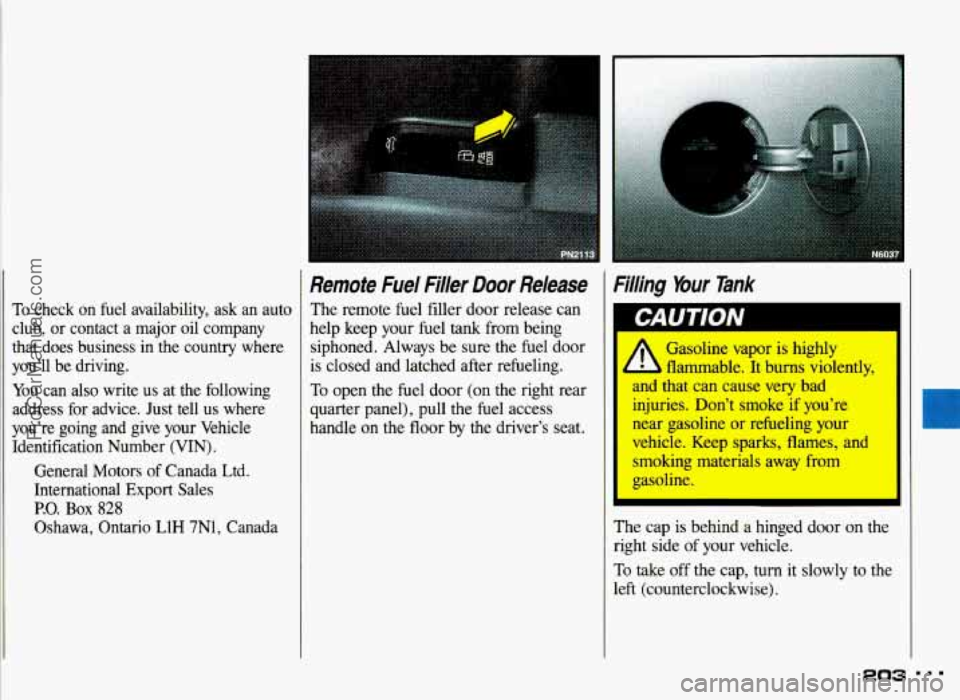
To check on fuel availability, ask an auto
club, or contact a major oil company
that does business in the country where
you’ll be driving.
You can also write us at the following
address for advice. Just tell us where
you’re going and give your Vehicle Identification Number (VIN)
.
General Motors of Canada Ltd.
International Export Sales
P.O. Box 828
Oshawa, Ontario L1H 7N1, Canada
Remote Fuel Filler Door Release
The remote fuel filler door release can
help keep your
fuel tank from being
siphoned. Always be sure the fuel door
is closed and latched after refueling.
To open the fuel door (on the right rear
quarter panel), pull the fuel access
handle on the floor by the driver’s seat.
Wing Your Tank
A Gasoline vapor is highly
and that can cause very bad
injuries. Don’t smoke
if you’re
near gasoline or refueling your
vehicle. Keep sparks, flames, and
smoking materials away from
gasoline.
L flammable. It burns violently,
I
‘he cap is behind a hinged door on the
ight side
of your vehicle.
o take off the cap, turn it slowly to the
:ft (counterclockwise).
203
ProCarManuals.com
Page 205 of 306
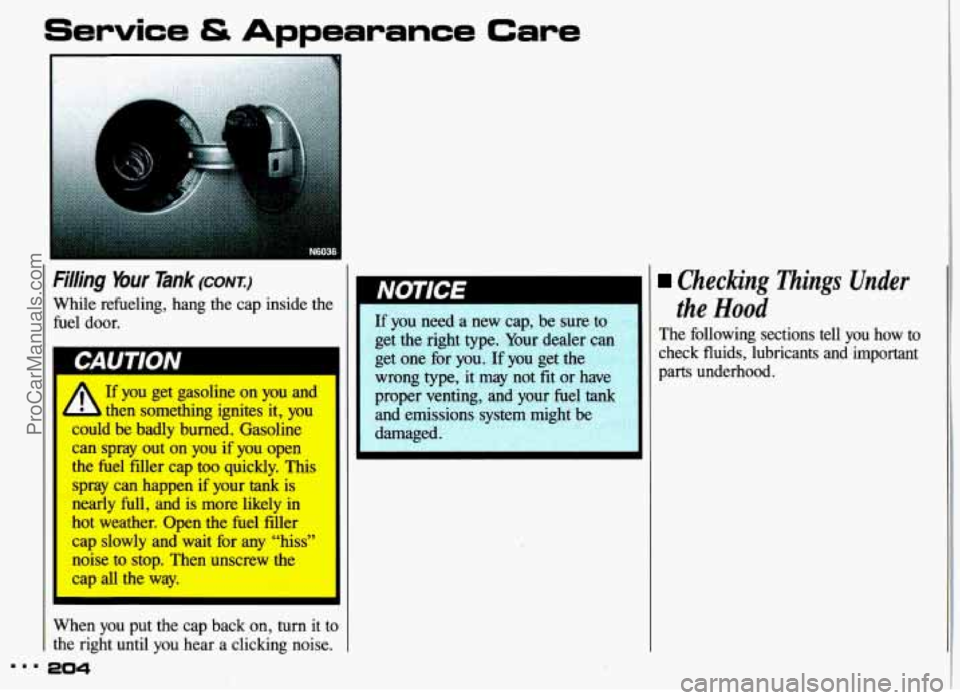
Service & Appearance Care
Filling Your Tank CON^)
While refueling, hang the cap inside the
fuel door.
A If you get gasoline on you and
- then something ignites it, you
could be badly burned. Gasoline
can spray out on you if you open
the fuel filler cap too quickly, This I
spray can happen if your tank is
nearly full, and is more likely in I
hot weather. Open the he1 filler
cap slowly and wait for any “hiss”
noise to stop. Then unscrew the
cap all the way.
When you put the cap back on, turn it to
the right until you hear a clicking noise.
204 ...
I’y ‘I ICIC
If you need a new cap, be sure to
get
the right type. Your dealer can , ,
get one for you. If you get the
wrong type, it may not fit or have
proper venting, and your fuel
tank
and emissions system might be
damaged. I
Checking Things Under
the Hood
The following sections tell you how to
check fluids, lubricants and important
parts underhood.
ProCarManuals.com
Page 210 of 306
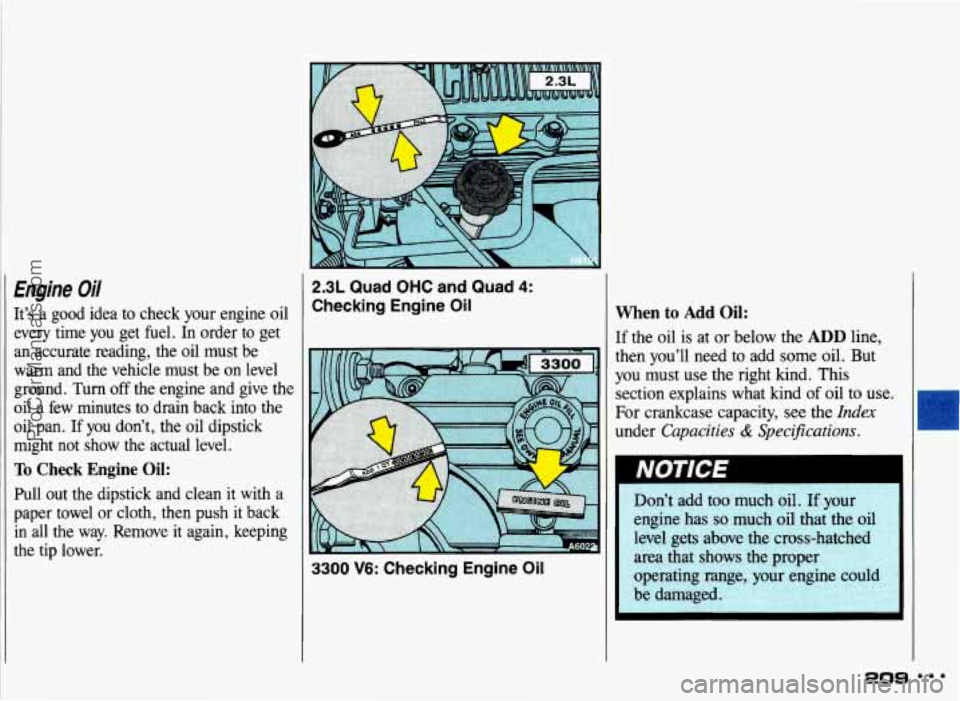
Engine Oil
It’s a good idea to check your engine oil
every time you get fuel. In order to get
an accurate reading, the
oil must be
warm and the vehicle must be
on level
ground. Turn
off the engine and give the
oil a few minutes to drain back into the
oil pan. If you don’t, the oil dipstick
might not show the actual level.
To Check Engine Oil:
Pull out the dipstick and clean it with a
paper towel or cloth, then push
it back
in all the way. Remove it again, keeping
the tip lower.
2.3L Quad OHC and Quad 4:
Checking Engine Oil
3300 V6: Checking Engine Oil
When to Add Oil:
If the oil is at or below the ADD line,
then
you’ll need to add some oil. But
you must use the right kind. This
section explains what kind
of oil to use.
For crankcase capacity, see the Index
under Capacities & Spec$kations.
20s
ProCarManuals.com